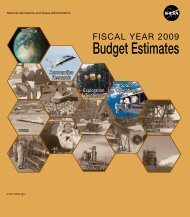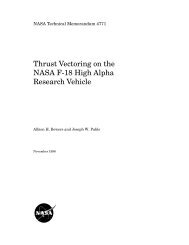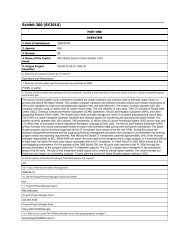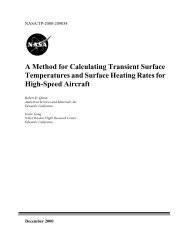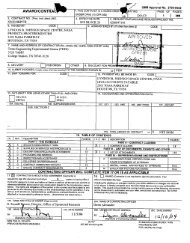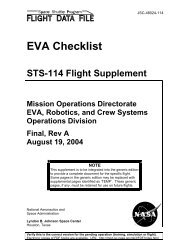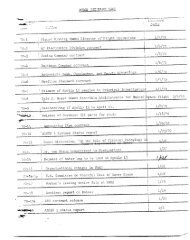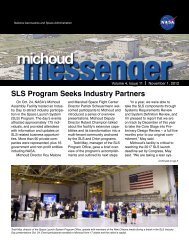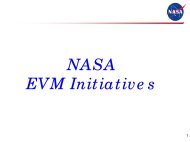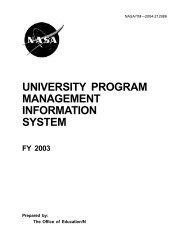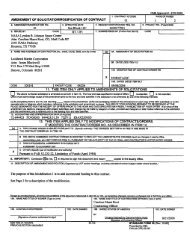Download - NASA
Download - NASA
Download - NASA
You also want an ePaper? Increase the reach of your titles
YUMPU automatically turns print PDFs into web optimized ePapers that Google loves.
National Aeronautics and Space Administration<br />
IT Talk<br />
March / April 2011 Issue 2<br />
Where Is Technology<br />
At <strong>NASA</strong> Headed<br />
Over The Next<br />
Five Years<br />
www.nasa.gov
IT Talk<br />
March/April 2011 Issue 2<br />
In this Issue<br />
Office of the CIO<br />
<strong>NASA</strong> Headquarters<br />
300 E Street, SW<br />
Washington, D.C. 20546<br />
Chief Information Officer<br />
Linda Y. Cureton<br />
OCIO Chief of Staff<br />
John Hopkins<br />
Editor and Publication Manager<br />
Eldora Valentine<br />
Graphic and Web Design<br />
Michael Porterfield<br />
IT Talk is an official publication of the<br />
Office of the Chief Information Officer<br />
of the National Aeronautics and<br />
Space Administration, Headquarters,<br />
Washington, D.C. It is published<br />
by the OCIO office for all <strong>NASA</strong><br />
employees and external audiences.<br />
For distribution questions or to<br />
suggest a story idea, email:<br />
john.hopkins@nasa.gov or<br />
eldora.valentine-1@nasa.gov<br />
To read IT Talk online visit:<br />
nasa.gov/offices/ocio/ittalk<br />
For more info on the OCIO:<br />
v www.nasa.gov/ocio<br />
v insidenasa.nasa.gov/ocio<br />
(Internal <strong>NASA</strong> network only)<br />
v facebook.com/<strong>NASA</strong>cio<br />
v twitter.com/<strong>NASA</strong>cio<br />
3<br />
4<br />
7<br />
10<br />
Message from<br />
the CIO<br />
Technology:<br />
Where Is Technology At<br />
<strong>NASA</strong> Headed Over The<br />
Next Five Years<br />
<strong>NASA</strong> Continues<br />
to Lead a Joint IT<br />
Forum for Federal<br />
Agencies Using SAP<br />
Why We Do IT<br />
for <strong>NASA</strong>
Technological innovation is more important than ever. We<br />
saw this first hand last year with <strong>NASA</strong>’s first IT Summit. Presenters<br />
from around the country shared their expertise on<br />
themes ranging from social networking and green IT to innovation,<br />
infrastructure, operations, IT security and privacy.<br />
Things are changing at a faster pace; everything is connected;<br />
and standards are slow to emerge. Without a doubt,<br />
new tablets are hot on the list of techno innovations, but<br />
what else is on the horizon How about a telescope that<br />
lets you see thousands of years into the past. It is also reported<br />
to have a database of over 4000 celestial bodies.<br />
Perhaps it’s not as exciting when it’s compared with a<br />
Hubble Telescope which can see over 13 billion years. But it<br />
does make you wonder where the technology is heading.<br />
Another big trend is cloud delivered content. This will give<br />
consumers the ability to get to data independent of the<br />
device. Content owners will get the shakes about intellectual<br />
property rights and CIOs will get the willies about<br />
information security. Relative to what multimedia companies<br />
are facing, I feel very hopeful that the financial potential<br />
will drive some breakthroughs in the management<br />
of this content. That’s good news for today’s CIOs who<br />
are exploring ways to manage content in the cloud.<br />
In this issue we’ll take a closer look at where Chief Technology<br />
Officers at the centers think <strong>NASA</strong> is headed<br />
down the super highway of technology. l<br />
Message<br />
from the<br />
CIO<br />
by Linda Cureton<br />
Teleworking—<br />
Nasa’s New Way<br />
Of Doing Business<br />
More Efficiently<br />
Tony Facca, ETADS Project Manager<br />
Want to reduce your environmental impact<br />
and save money at the same time Several<br />
<strong>NASA</strong> Centers recently participated in the<br />
Telework Exchange’s Telework Week, February<br />
14–18, 2011. The Emerging Technology<br />
and Desktop Standards (ETADS) group at the<br />
Glenn Research Center in Ohio fully participated<br />
by maintaining all of their normal work<br />
activities from home offices for two straight<br />
days. Tony Facca, the ETADS Project Manager,<br />
forwarded the registration information<br />
to other <strong>NASA</strong> organizations, including the<br />
<strong>NASA</strong> Office of the Chief Information Officer,<br />
and support for the idea quickly grew.<br />
So how did teleworking impact the <strong>NASA</strong><br />
environment In those two days, eight<br />
members of the ETADS staff saved an estimated<br />
662 pounds of pollutants and $498<br />
in transportation costs. Overall, 1,751 <strong>NASA</strong><br />
employees who pledged to support Telework<br />
Week saved an impressive 97,809<br />
pounds (49 tons) of pollutants and $74,000.<br />
The Telework Exchange estimates a savings<br />
of more than 4 million pounds of pollutants<br />
and $3 million if these employees<br />
teleworked just once a week for a year.<br />
Successful telecommuting does require planning.<br />
Not all services operate the same from<br />
home networks. For example, some <strong>NASA</strong><br />
resources require authentication through a Virtual<br />
Private Network (VPN). So be sure to test<br />
remote access before you need it. Everyone<br />
in the DC area will remember Snowmageddon<br />
2010 (February 5–6). This was the remarkable<br />
blizzard that buried the mid-Atlantic under<br />
2 - 3 feet of snow. Effective telework practices<br />
kept vital services operating and allowed<br />
some workers to avoid a treacherous voyage.<br />
With a little advanced planning, telecommuting<br />
can help you live lightly on the Earth,<br />
save money, and live a happier, healthier life.<br />
For more information visit https://<br />
etads.nasa.gov/teleworkweek l<br />
<strong>NASA</strong> OCIO IT Talk March/April 2011 3
Where Is Technology At <strong>NASA</strong> He<br />
Technological innovation is more important than<br />
ever. We saw this first hand last year with <strong>NASA</strong>’s<br />
first IT Summit. Presenters from around the country<br />
shared their expertise on themes ranging from<br />
social networking and green IT to innovation,<br />
infrastructure, operations, IT security and privacy.<br />
The IT Summit helped us get closer to goals through<br />
the sharing of IT innovations across the Agency<br />
while learning from the efforts of other agencies<br />
and the private sector. So IT Talk decided to ask<br />
several Chief Technology Officers at the <strong>NASA</strong><br />
Centers where they think <strong>NASA</strong> is headed down the<br />
superhighway of technology. Many have a unique<br />
perspective on what key techno innovations are on<br />
the horizon for the Agency over the next 5 years.<br />
Tsengdar Lee—<strong>NASA</strong> Deputy CTO for IT<br />
A few years ago, I was managing<br />
a multi-million dollar congressional<br />
directed project (a.k.a. earmark) for<br />
the agency. A land grant university<br />
was building a computing center for<br />
their research use. I asked the vice<br />
president why he wanted to build a<br />
computing center and what was the strategic value<br />
the computing center will bring to the university. The<br />
vice president replied that a computing center would<br />
allow the university to compete in many scientific<br />
and engineering research areas with well established<br />
uni versities and cost less than building a wet lab or<br />
robotic lab. If you think carefully about the response,<br />
it implies (1) the computing center brings up the science<br />
and engineering competitiveness and (2) the<br />
information technology has a lower barrier to entry.<br />
As we move toward establishing <strong>NASA</strong> comput ing<br />
services, we must be mindful to align with <strong>NASA</strong>’s<br />
core missions. Only through a tight in tegration of information<br />
technology with the core science and technology<br />
activities can we build up the competitiveness<br />
of our core sci ence and engineering. Then we will fully<br />
realize the strategic value of information technology.<br />
4 www.nasa.gov<br />
Chris C. Kemp—<strong>NASA</strong> CTO for IT<br />
Current innovations in cloud-based data processing<br />
and storage, advanced networking and increasingly<br />
powerful mobile devices will enable<br />
ubiquitous access to information, and allow us to<br />
seamlessly move and interact with data across<br />
platforms and in the places it’s needed most.<br />
Advancements in networking such as LTE, WiMAX,<br />
LTE 2, WiMAX-Advanced and up to 100-gigabit networking<br />
will push data further and faster. Cloud computing technology<br />
will enable users to place larger and more complex data<br />
sets in the cloud, accessing and interacting with data from any<br />
internet-ready device. It will also allow <strong>NASA</strong> to move increasingly<br />
voluminous datasets to different sites more easily.<br />
16 and 11nm semiconductor manufacturing processes and the use<br />
of alternative materials will increase performance while lowering heat<br />
production and energy consumption in system-on-a-chip (SOC) processors.<br />
This will allow smaller devices such as smart phones, tablets<br />
and netbooks to fulfill a greater proportion of our computing needs.<br />
At the same time, this increase in bandwidth and processing<br />
power makes new means of communication like HD video<br />
conferencing more practical and accessible. With gigapixel<br />
and terapixel-resolution instruments and advanced approaches<br />
to visualization such as 3D capture and projection, Computer<br />
Aided Virtual Environments and 4, 8, and 16K displays,<br />
we will be able to immerse ourselves in a world of data.<br />
The end result is that <strong>NASA</strong> personnel will be able to accomplish<br />
more from a greater range of locations, and that these trends will<br />
continue to make the world an even<br />
smaller place.<br />
James McClellan—JSC CTO for IT<br />
“I don’t think it’s much of a leap to say that 5 years<br />
from now the average <strong>NASA</strong> employee will be using<br />
a mobile computing platform that is essentially a nice<br />
display with a browser connected to all their content<br />
and social connections through the ubiquitous ‘cloud.’<br />
That cloud will be capable of housing both normal and<br />
secure content. Networks will have removed the penalty<br />
of being mobile with multi-megabit wireless connectivity virtually<br />
everywhere. Employees may even be supplying their own preferred<br />
device (Bring Your Own Device–BYOD), enabled by the ability for<br />
<strong>NASA</strong> applications to be securely used on even a personal device<br />
via mobile app management profiles. And IT as we know it will be on<br />
the way out, if not already gone, due to the consumerization of IT. We<br />
have to start positioning ourselves to become the “go to” IT consultants<br />
if we are to deliver value to our customers and the missions.”
aded Over The Next Five Years<br />
Ray O’Brien AMES CTO for IT<br />
“I believe cloud technology will<br />
have a tremendously positive<br />
impact on the Agency. Having recently<br />
transitioned from managing<br />
NEBULA, <strong>NASA</strong>’s cloud computing<br />
initiative, to Ames CTO, it is<br />
clear to me that <strong>NASA</strong> will realize<br />
significant savings using the shared-resource<br />
model. However, the agility cloud computing<br />
provides is the real value to <strong>NASA</strong>. It enables<br />
users’ instant access to pooled computer<br />
resources, and soon many <strong>NASA</strong> prototypes,<br />
pilots, and proof-of-concept activities may be<br />
accomplished without investing in dedicated<br />
physical hardware. Projects with limited duration<br />
processing requirements, or with planned<br />
peaks, may address their requirements without<br />
investing in over-specified hardware. Other<br />
agility benefits include enabling rapid-start software<br />
development projects and the ability to<br />
dynamically scale to accommodate unexpected<br />
requirements and peak loads. As business<br />
and operations models are refined to support<br />
public and private cloud services, <strong>NASA</strong> will increasingly<br />
and enthusiastically adopt the technology.<br />
Now is a great time to start becoming<br />
familiar with cloud computing.”<br />
David Voracek, Dryden Chief Technologist<br />
Tom Soderstrom—JPL CTO for IT<br />
Tom Soderstrom serves as the IT Chief Technology<br />
Officer at <strong>NASA</strong>’s Jet Propulsion Laboratory (JPL)<br />
where his mission is to identify, infuse, and adopt new<br />
IT technologies into JPL’s environment. Before working<br />
at JPL, Tom led remote teams and large-scale IT best practices<br />
development and change efforts in both small startups and large<br />
commercial companies. He performed these roles in both international<br />
venues and in the U.S. commercial and Government consulting<br />
arenas. While at JPL, Tom led a collaborative, practical, and handson<br />
approach to investigate emerging industry IT technology trends<br />
that matter especially to JPL, <strong>NASA</strong>, and large enterprises. His research<br />
shows that the key trends for the next decade are driven by<br />
the emerging need to “work with anyone from anywhere with any<br />
data and using any device.” The specific trends identified include:<br />
• Extreme Collaboration Made Simple—quick and simple will rule the day;<br />
• The Pervasive Cloud—Cloud computing is part of every strategy;<br />
• Eco Friendliest—It will be a competition to be seen as the most energy frugal;<br />
• Refocused Cyber Security—IT security advises at the start of all efforts;<br />
• Consumer Driven IT—The end users determine and help build the IT;<br />
• You’ve got apps—No more large applications, but small, agile apps;<br />
• Immersive Visualization and Interaction—Think Microsoft Kinect but bigger;<br />
• Big Data—Huge data sets and many devices reporting all the time; and<br />
• Human Behavior—How we meet the changing expectations for computing.<br />
Simply speaking, IT will be transformed into “Innovating Together” and<br />
the traditional IT employees will become consultants to the <strong>NASA</strong> businesses.<br />
The results will be drastically improved and relevant IT embedded<br />
in the <strong>NASA</strong> missions. The most significant improvements will be<br />
how we intelligently visualize massive amounts of data on our mobile devices<br />
and have continuous access at previously unimagined bandwidth.<br />
Flight test, analysis, computational fluid dynamics,<br />
and wind tunnel data is gathered, generated,<br />
and graphed on a lot of flight projects we do at<br />
<strong>NASA</strong>. There is no easy way to bring all this data<br />
together for comparison, validation, and reporting.<br />
I would love to see an innovation where we can<br />
bring this data together as easily as we can<br />
search information on the Web. I imagine a day where a student<br />
studying aeronautics or space technology could use data generated from a test stand at<br />
Glenn or Marshall, wind tunnels at Langley, flight data from Dryden, or space data from JPL or Johnson, to take<br />
the equations and apply real data to understand the physics. A person develops a new CFD program and could<br />
easily find flight data that could be used to validate their code. The data search would include images, video and<br />
audio that was generated during the project. This innovation would take a lot of coordination between all the<br />
people that generate the data on a project. <strong>NASA</strong> works with advanced technologies that may not be operational<br />
for several years. We have to be generating the data with the thought that it would be searchable 10 years after<br />
the project ended. The value of this data is immense and we need to figure out how to make it easier to access.<br />
Continued on page 6<br />
<strong>NASA</strong> OCIO IT Talk March/April 2011 5
Continued from page 5<br />
Peter Hughes, GSFC CTO<br />
It is hard to accurately predict technology innovations<br />
in the next five years, yet it is certain that space<br />
systems will become increasingly more complex and<br />
capable. One of drivers behind the increased complexity<br />
is a very clear trend toward miniaturization,<br />
especially for certain classes of scientific instruments<br />
and platforms. Continued ad vances in miniaturized<br />
technologies (e.g., Micro-Electro-Mechanical Systems and nanotechnology),<br />
electronics, and advanced materials are examples.<br />
It also is certain that future missions and instruments will return<br />
greater volumes of data. In many cases, these increases will be significant.<br />
Fortunately, advances in space communications technologies,<br />
such as optical free-space communications, promise greater scientific<br />
data volume transport. Furthermore, advances in smaller and higherperforming<br />
on-board computing capabilities, such as SpaceCube and<br />
other Application Specific Integrated Circuits (ASICs) that can tolerate<br />
extreme environments, will enhance data processing. They will provide<br />
greater on-board data processing and classification, event/feature<br />
detection, product generation, and real-time distribu tion. The advanced<br />
onboard processing also will enable increased system autonomy and<br />
autonomous collaboration between science platforms.<br />
With these “safe” predictions, it is perhaps more exciting to think<br />
about—but nearly impossible to forecast—the breakthrough<br />
innovations that will result from the newly created Office of the<br />
Chief Technologist’s “Space Technology” program. By reinvigorating<br />
technology innovation within the Agency and throughout<br />
the space-technology community, I am quite optimistic that we<br />
will witness a strong increase in radical innovations that will<br />
overwhelm the incremental advances that our recent dry spell in<br />
Agency technology funding created.<br />
Ed McLarney, LaRC CTO<br />
GRC—Courtesy of Don Sosoka – Division Chief, Mission<br />
Support Computing Office, Tony Facca – Project Manager<br />
for ETADS (Emerging Technology & Desktop Standards),<br />
and Jay Horowitz – Senior Computer Scientist<br />
One of the most dynamic areas of IT is mobile computing and, as such,<br />
it and related technologies provide ample innovation opportunities.<br />
Mobile Computing: At <strong>NASA</strong>, use of smartphone technology has more<br />
than doubled during 2010 (5,300 connected devices in January 2010<br />
to almost 11,300 in January 2011). Improvements in security will attract<br />
the more risk-averse users. Mobile device management technology<br />
will continue to improve, enabling <strong>NASA</strong> to secure, monitor, and<br />
manage corporate data on both Government-issued and employeeowned<br />
devices. Tablets will continue to gain acceptance in <strong>NASA</strong><br />
with increased vendor diversity, though Apple will remain the leader.<br />
Mobile Apps: Everyone is familiar with the availability of the thousands<br />
of applications for mobile devices such as smartphones,<br />
pads and tablets. The increased speed available with 4G WiMax<br />
and LTE will enable a whole new generation of mobile apps, including<br />
HD videoconferencing. <strong>NASA</strong> customers will expect more<br />
applications to provide a mobile device interface like WebTads.<br />
Opportunities exist for the development of more <strong>NASA</strong>-specific<br />
applications that take advantage of resident functionality (e.g.,<br />
GPS) for increased productivity. As computing power continues to<br />
grow in mobile computing devices, <strong>NASA</strong> will increasingly have<br />
the ability to develop more direct mission-related applications for<br />
use where anywhere availability to those applications is of value.<br />
Data Transformation: As the variety of computing platforms from<br />
which <strong>NASA</strong> users will want to access information increases, there<br />
will be a growing need to transform data (photographs, videos,<br />
spreadsheets, etc.) to fit the end-user environment. Technology<br />
to perform these transformations automatically and intelligently<br />
will become increasingly important. Use of extract, transform, and<br />
load (ETL) processes, will allow only one version of a document<br />
that can be transformed on demand and incorporated into<br />
more complex documents.<br />
As a brand new <strong>NASA</strong> employee, I am thrilled to<br />
join the team as CTO for the Langley OCIO, and<br />
look forward to working closely with customers<br />
and technologists, both locally and across the<br />
Agency. Over the next five years, we will relentlessly<br />
pursue the vision: “Provide anytime, anywhere<br />
access to information from any device.” It sounds<br />
simple, but this onion has many layers. We will conduct collaborative,<br />
iterative customer outreach to tie technology innovation directly<br />
to mission requirements. We will continue to partner with customer<br />
technical experts to help them achieve their goals. Specific emerging<br />
technology areas will include: pervasive collaboration & telepresence<br />
tools, migrating many applications to the cloud, embracing agile<br />
deployment of web 2.0 and social media tools, enhanced decadal<br />
information archive, large-scale mobile device deployment, intelligent<br />
search & knowledge tools, automated metatagging of text &<br />
visual files, and data center optimization. These emerging technology<br />
areas will be supported by upgrading wireless networks, adopting<br />
best-of-breed new IT security tools, and numerous other infrastructure<br />
enhancements. We will complement technical developments<br />
with innovative and agile policies & procedures for IT security,<br />
licensing, intellectual property, and legal considerations. Customer<br />
focus, technical innovation, and enhanced policies and procedures<br />
form a balanced approach to work toward the technical vision.<br />
6 www.nasa.gov<br />
David Walters, SSC CTO for IT<br />
Adoption of mobile technology will continue over the next 5 years to<br />
transform <strong>NASA</strong> into a mobile workforce where access to IT services<br />
is omnipresent. More powerful multi-core central processing units<br />
(CPUs) increased memory, and faster data networks will make the mobile<br />
device the preferred IT appliance for many <strong>NASA</strong> employees.<br />
The virtual office will become commonplace with the adoption of mobile<br />
cloud technology providing remote access to the same data as available on<br />
a user’s desktop PC. Utilizing the cloud, a mobile device could become a<br />
“thin client” and even function as a desktop PC through a docking station<br />
for peripheral support. Advancements in unified communication will<br />
continue to improve the integration of mobile devices with other communication<br />
services such as telephone, fax, e-mail, and instant messaging.<br />
Current use of mobile devices has improved the way <strong>NASA</strong> communicates,<br />
but there is greater potential for mobile applications to revolutionize our<br />
IT landscape. Applications are now possible that have never been envisioned<br />
in a mobile environment, particularly with an available toolkit that<br />
includes location tracking, barcode scanning, photo capture, and credentia<br />
scanning. <strong>NASA</strong> has already started the investment into mobile device<br />
application development. As a result, <strong>NASA</strong>’s IT culture will shift from<br />
skepticism of mobile devices to embracement over the next 5 years. l
<strong>NASA</strong> Continues to Lead a Joint IT Forum for Federal<br />
Agencies Using Systems Application Products (SAP)<br />
l<br />
Many federal agencies, including<br />
<strong>NASA</strong>, have implemented Systems<br />
Application Products (SAP) software<br />
as their enterprise financial systems.<br />
For years, each agency endeavored<br />
separately to discuss issues with the<br />
SAP vendor, and to drive solutions<br />
that would meet requirements and<br />
challenges unique to the public sector.<br />
When a major SAP upgrade raised the<br />
stakes for all agencies in that category,<br />
<strong>NASA</strong> took the initiative to form a group<br />
that could speak—and be heard—<br />
authoritatively to address public sector<br />
issues. Since its inception in 2007,<br />
the SAP Federal Forum has grown<br />
to include eight Federal agencies,<br />
some with multiple installations. The<br />
SAP software vendor provides key<br />
representation and participates in<br />
the forum’s quarterly meetings.<br />
The impetus for the creation of the<br />
forum came about as a result of<br />
<strong>NASA</strong>’s SAP Version Update (SVU)<br />
project implemented by <strong>NASA</strong>’s<br />
Enterprise Applications Competency<br />
Center (NEACC) at the beginning of<br />
FY07. <strong>NASA</strong> was the first U.S. Federal<br />
agency to upgrade to the current<br />
version of SAP and the NEACC quickly<br />
became a critical source of lessons<br />
learned for other federal organizations<br />
planning similar upgrade projects. The<br />
first meeting was held April 2007 at the<br />
NEACC facility in Huntsville, Alabama,<br />
and focused on <strong>NASA</strong>’s upgrade<br />
experience. The relationships with SAP<br />
and the other federal organizations<br />
quickly evolved into what is now<br />
referred to as the SAP Federal Forum.<br />
SAP feels strongly about close<br />
collaboration with Federal agencies. To<br />
maintain certified status of Federallycompliant<br />
software, they must provide<br />
system capabilities to satisfy public<br />
sector requirements. In the past, they<br />
were interpreting these requirements<br />
without direct input from agencies<br />
but the Federal Forum now allows<br />
for close collaboration prior to<br />
development efforts so that the<br />
functionality provided is what<br />
agencies truly need to fully<br />
satisfy requirements with as little<br />
custom development as possible.<br />
Over the past couple of years, member<br />
agencies have collectively agreed to a<br />
listing of priorities to assign to working<br />
groups. These groups consist of key<br />
subject matter experts with detailed<br />
knowledge of the functionality or<br />
requirements. SAP also provides subject<br />
matter experts and developers to work<br />
with the group to address the concerns.<br />
The first working group effort addressed<br />
issues with a standard reporting shell<br />
for the Treasury Report on Receivables,<br />
requirements for which are provided<br />
by Treasury and are very complex. The<br />
mechanism SAP originally provided had<br />
performance and configuration issues.<br />
The working group successfully worked<br />
through the issues with SAP developing<br />
changes to the report and testing along<br />
the way. After months of collaboration<br />
and effort, the redesigned report was<br />
made available and implemented<br />
successfully at one agency, with several<br />
other implementations in progress.<br />
Most importantly, the functionality<br />
now meets agencies’ needs.<br />
The Federal Forum held its first annual<br />
face-to-face meeting in 2010. The<br />
meeting’s stated purpose was to<br />
provide an opportunity for agencies<br />
to share their fiscal year-end-close<br />
experiences, and to discuss and<br />
prioritize challenges. At that meeting,<br />
the participating agencies agreed that<br />
future annual meetings’ sole focus<br />
no longer needed to be year-end,<br />
but should expand into other topics<br />
of interest. The 2011 annual meeting<br />
was held January 25 and 26, with<br />
over 80 participants representing SAP,<br />
Federal agencies, and consultants<br />
who had all collaborated to develop an<br />
agenda tailored to deliver meaningful<br />
content to everyone. For the second<br />
year in a row, the Department of<br />
Interior hosted the meeting at their<br />
facilities in Reston, Virginia. Hot<br />
topics included Enhancement Pack<br />
5, which is currently in ramp-up,<br />
the potential Federal requirement<br />
to withhold 3 percent of vendor<br />
payments, an upcoming Treasury<br />
change from a 9-digit general ledger<br />
account format to a 6-digit general<br />
ledger account format, and a change<br />
from Federal Agencies’ Centralized<br />
Trial-Balance System (FACTS) I and<br />
II to the Governmentwide Treasury<br />
Account Symbol Adjusted Trial Balance<br />
System (GTAS), to name a few.<br />
<strong>NASA</strong> benefits from the Federal<br />
Forum in many ways. Not only do the<br />
Agency’s requirements get included<br />
in helping to guide SAP’s public<br />
sector roadmap, but the insight<br />
received back helps to guide the<br />
strategic roadmap for maintaining<br />
<strong>NASA</strong>’s financial systems. Information<br />
on content and timeline for SAP<br />
delivering new system capabilities<br />
allows <strong>NASA</strong> to effectively develop an<br />
implementation schedule and factor<br />
this work in with other priorities.<br />
This year the Federal Forum will be<br />
working to increase Federal agencies’<br />
participation in the Americas’ SAP<br />
Users’ Group (ASUG) Public Sector<br />
Special Interest Group (SIG). Working<br />
more closely with ASUG will allow us<br />
to take greater advantage of ASUG’s<br />
communication tools. It also allows us<br />
to combine our voices with other SAP<br />
customers facing similar challenges<br />
and opportunities. We will continue<br />
to hold quarterly conference calls to<br />
add or remove items on the priority<br />
list. We will be appointing customer<br />
representatives to head up the priority<br />
working groups on a variety of specific<br />
topics to address those things that are<br />
most important to Federal agencies.<br />
There is a strong need for this group<br />
to continue. Significant benefits have<br />
already been provided, and the goal<br />
is to continue to reap those benefits<br />
for <strong>NASA</strong> and all member agencies.<br />
Federal Forum Member Agencies<br />
Navy ERP (NavAir, SPAWAR)<br />
Army (GFEBS, LMP, USAMMA)<br />
IRS<br />
DOI<br />
CBP<br />
USDA<br />
DLA<br />
<strong>NASA</strong><br />
Questions about the SAP Federal<br />
Forum may be addressed to LaTonya<br />
Powell at the <strong>NASA</strong> Enterprise<br />
Applications Competency Center. l<br />
<strong>NASA</strong> OCIO IT Talk March/April 2011 7
ACES 101<br />
Agency Consolidated End-user<br />
Services (ACES) is a single award, Firm<br />
Fixed Price (FFP), Indefinite-delivery,<br />
Indefinite-quantity (IDIQ) contract with<br />
a minimum contract value of $5 million<br />
and maximum contract value of $2.5<br />
billion. The ACES contract will provide<br />
desktop, printer, e-mail and other enduser<br />
services to the <strong>NASA</strong> community.<br />
The Period of Performance for<br />
the contract is 10 Years (4-year<br />
base + two 3-year options):<br />
Base: July 1, 2011 – June 30, 2015<br />
*This contract is currently under protest.<br />
The start date may be adjusted.<br />
Option 1: July 1, 2015 – June 30, 2018<br />
Option 2: July 1, 2018 – June 30, 2021<br />
Programmatic direction will be provided<br />
by the Office of the CIO End-user<br />
Service Executive and oversight will<br />
be shared by the Service Executive<br />
and the <strong>NASA</strong> Shared Services<br />
Center (NSSC) CIO to the End-user<br />
Service Office, located at the NSSC.<br />
The End-user Service Office will<br />
include: the End-user Services Manager<br />
(EUSM), Contracting Officer’s Technical<br />
Representative (COTR), the Integration<br />
Lead, Service Element Managers, and<br />
Project Member Support. Centers will<br />
have Subject Matter Experts, Service<br />
Element Technical Experts, Center<br />
Integration Leads, Resource Analyst(s)<br />
and Project Member Support. All<br />
business support functions including<br />
Contracting Officer and Specialists,<br />
Cost Analysis, and Resource<br />
Analysis will be performed by the<br />
I3P Business Office at the NSSC.<br />
The following are five main<br />
goals of ACES:<br />
• Goal 1: Consolidate the provisioning<br />
of end-user services across all<br />
<strong>NASA</strong> Centers and Facilities<br />
using a single Agency solution<br />
• Goal 2: Ensure <strong>NASA</strong>’s mission<br />
is enabled by the Agency<br />
Consolidated End-user solution<br />
• Goal 3: Improve the Enduser<br />
IT security posture<br />
• Goal 4: Improve the management<br />
of <strong>NASA</strong>’s IT infrastructure<br />
• Goal 5: Enable a mechanism<br />
for transformation of <strong>NASA</strong>’s<br />
end-user services in support of<br />
emerging mission requirements<br />
Specific Objectives for each<br />
Goal are detailed in the ACES<br />
Performance Work Statement.<br />
Stay tuned for an ACES 102 article<br />
in the next edition of IT Talk. We’ll<br />
cover the specifics regarding<br />
the types of computers, laptops,<br />
printers, cell phones, and services<br />
that are going to be delivered.<br />
For more information about ACES,<br />
see: http://insidenasa.nasa.gov/<br />
ocio/i3p/i3p_aces_faq.html l<br />
Full Steam<br />
Ahead for I3P<br />
New procurements under<br />
<strong>NASA</strong>’s IT Infrastructure<br />
Integration Program (I3P)<br />
are shaping up. I3P is<br />
<strong>NASA</strong>’s program to provide<br />
Agency-wide management,<br />
integration, and delivery of<br />
information technology (IT)<br />
infrastructure services to<br />
support mission success.<br />
I3P focuses on consolidating<br />
<strong>NASA</strong>’s infrastructure services<br />
in the areas of Web services,<br />
Integrated network and<br />
communications services,<br />
Enterprise applications, End-user<br />
services, Enterprise data center,<br />
and Agency Service Desk.<br />
The Enterprise Applications<br />
Service Technologies (EAST)<br />
contract was awarded last<br />
October and began operations<br />
on Feb 1, 2011. The Agency<br />
Consolidated End-user Services<br />
(ACES) contract was awarded<br />
in December 2010, but is<br />
currently under protest. ACES<br />
will be the replacement for the<br />
Outsourcing Desktop Initiative<br />
for <strong>NASA</strong> (ODIN). The U.S.<br />
Government Accountability<br />
Office has 100 days to issue an<br />
opinion; an answer is expected<br />
in late April. The <strong>NASA</strong> Shared<br />
Services Center continues to set<br />
up the Enterprise Service Desk<br />
and Ordering System to serve<br />
as the consolidated help desk<br />
and self service Web site for<br />
the new contracts. The <strong>NASA</strong><br />
Integrated Communications<br />
Services (NICS) and the Web<br />
Enterprise Service Technologies<br />
(WEST) contracts continue their<br />
work in evaluating proposals,<br />
a selection is expected in the<br />
coming months. When it is<br />
all completed, this Agencywide<br />
effort will better enable<br />
the <strong>NASA</strong> mission, improve<br />
security, and gain efficiencies. l<br />
8 www.nasa.gov
JPL Mission Infrastructure<br />
Service (MIS)<br />
By Whitney Haggins, Jet Propulsion Laboratory, California Institute of Technology<br />
JPL’s Office of the Chief Information Officer has implemented an IT<br />
infrastructure that will reduce cost as well as risk while increasing the<br />
flexibility of the computing environment during the Flight Projects life<br />
cycle. The Mission Infrastructure Service (MIS) is a shared IT service<br />
infrastructure that provides high-performance hardware and dynamically<br />
provisioned IT resources on a virtual machine. By eliminating the initial<br />
hardware investment and reducing system administration costs, the total<br />
cost of ownership is sharply reduced. Projects no longer have to worry<br />
about the IT infrastructure used to support critical mission operation<br />
that requires large amount of servers and workstations, nor do they<br />
need to keep and store excess servers and workstations. Now they can<br />
subscribe to the MIS and pay for what they use only when they use it.<br />
The MIS infrastructure provides blade server modules<br />
that can be accessed using thin-client technology.<br />
Before: Extra workstations stored in a cubicle.<br />
After: Workstations replaced by blade servers in racks within a secure server room.<br />
Blade servers have been installed in a server room in the Space Flight<br />
Operation Facility (SFOF) and can support either Solaris or Linux<br />
operating systems. The SunRay thin clients and monitors have been<br />
installed in the special event Mission Support Area in the SFOF.<br />
The MIS infrastructure has been thoroughly tested by the Office of<br />
the CIO and several flight projects including: Cassini, Dawn, Mars<br />
Exploration Rovers (MER), Mars Reconnaissance Orbiter (MRO), Mars<br />
Science Laboratory (MSL), and it was used successfully by EPOXI<br />
during their encounter with Comet Hartley on November 4, 2010. l<br />
<strong>NASA</strong> IT Summit—<br />
Save the Date!<br />
<strong>NASA</strong>’s second IT Summit will be held on<br />
August 15–17, 2011, at the Marriott Marquis<br />
in San Francisco, California. <strong>NASA</strong> Associate<br />
Administrator for IT and Chief Informa tion<br />
Officer Linda Cureton will host the event.<br />
The overarching goal of <strong>NASA</strong>’s IT Summit<br />
is simple. It will provide an integrated<br />
forum for <strong>NASA</strong>’s IT community which<br />
includes all of its working groups. And<br />
it will enable the <strong>NASA</strong> IT community to<br />
create a venue for continuous learning that<br />
provides that provides perspectives on<br />
the internal and external IT landscape.<br />
<strong>NASA</strong> has partnered with the nonprofit<br />
National Institute of Aerospace, which acts<br />
as a liaison between <strong>NASA</strong>, industry, public<br />
partners and academia to secure resources<br />
to better promote <strong>NASA</strong>’s vision and the role<br />
of IT. The partnership will also enable an open<br />
dialogue among a broader IT community.<br />
Participants benefitting from these<br />
discussions include IT representatives from<br />
<strong>NASA</strong> Mission Directorates, <strong>NASA</strong> Mission<br />
Support organizations, academia, other<br />
Federal agencies, and Federal IT groups.<br />
The Summit will include best practices<br />
in broad IT subject areas as well as on IT<br />
mission enabling capabilities, IT security,<br />
open government, IT Enterprise Architecture,<br />
and social networking and innovation.<br />
Collaboration will be a particular emphasis<br />
for the 2011 IT Summit, as the <strong>NASA</strong> Office<br />
of Education has become a significant<br />
partner in promoting education through<br />
IT. Together, we will explore the impact<br />
of the IT workforce pipeline through<br />
the use of instructional technology.<br />
In addition Ames Research Center, Dryden<br />
Flight Research, Glenn Research and Langley<br />
Research Center are plugging into the IT<br />
Summit audience and venue location. The<br />
centers are co-hosting TEDx <strong>NASA</strong>. This will<br />
give IT Summit attendees the opportunity to<br />
learn, discuss, and collaborate on innovative<br />
ideas in the fields of technology, entertainment,<br />
and design. Attendees will be able to apply<br />
these ideas to their own challenges.<br />
So make your reservations now to attend. For<br />
more information about IT Summit registration<br />
go to www.regonline.com/itsummit2011 l<br />
<strong>NASA</strong> OCIO IT Talk March/April 2011 9
Why We Do IT for <strong>NASA</strong><br />
Lynn Heimerl and Gerald Steeman, Scientific and Technical Information (STI) Program Office<br />
Many <strong>NASA</strong> researchers are well<br />
known in their specific fields and<br />
have received numerous honors and<br />
distinctions, but they may not be a<br />
household name to you. Perhaps<br />
they have never flown a Space<br />
Shuttle, broken the sound barrier, or<br />
made headlines by diving deep into<br />
the ocean depths. However, their<br />
<strong>NASA</strong> research and contributions put<br />
them, in our minds, in the category<br />
of <strong>NASA</strong>’s unsung heroes. In this<br />
article, we highlight Joel S. Levine<br />
of <strong>NASA</strong> Langley Research Center.<br />
Joel is a senior research scientist in<br />
Langley’s Science Directorate, and<br />
he has been the principal investigator<br />
and chief scientist of the proposed<br />
<strong>NASA</strong> Langley ARES (Aerial Regionalscale<br />
Environmental Surveyor) Mars<br />
Airplane Mission. ARES is Langley’s<br />
proposed robotic, rocket-powered<br />
Mars airplane designed to investigate<br />
the atmosphere, surface, and subsurface<br />
of Mars. ARES was one of four<br />
finalists in the first Mars Scout Mission<br />
competition. See Joel’s talk on ARES<br />
for TED (Technology, Entertainment,<br />
and Design) at http://www.ted.<br />
com/talks/lang/eng/joel_levine.<br />
html. “The discovery of life outside<br />
of the Earth,” Levine says, “will be a<br />
major scientific discovery! When we<br />
discover life on Mars, how will we<br />
determine unambiguously whether<br />
it is life indigenous to Mars (life that<br />
originated and evolved on Mars) or<br />
Earth life that was inadvertently carried<br />
from Earth to Mars by earlier Mars<br />
landers and/or rovers” Heavy stuff.<br />
Joel Levine has put some time into<br />
the topic of Mars. He is particularly<br />
proud of two publications. The first is<br />
the 1976, A New Estimate of Volatile<br />
Outgassing on Mars, which was<br />
published as the two Viking Orbiters<br />
and Landers were en route to Mars.<br />
Levine says, “The paper presented<br />
geochemical evidence that early<br />
Mars had a very dense atmosphere<br />
(more than 100 times denser than<br />
today) and abundant and wide-spread<br />
liquid water existed on the surface<br />
of early Mars.” The second, Trace<br />
Gases in the Atmosphere of Mars-An<br />
Indicator of Microbial Life, published<br />
in 1989, theorized how the trace<br />
gas composition of the atmosphere<br />
of Mars can be used to determine<br />
whether there is life on Mars today<br />
and predicted that the discovery of<br />
methane in the atmosphere of Mars<br />
would be a very strong indicator of<br />
the presence of life on Mars. “Fifteen<br />
years later, in 2004,” Levine states,<br />
“methane was discovered in the<br />
atmosphere of Mars!” Imagine waiting<br />
15 years to have your work validated.<br />
Joel coedited a 974-page book<br />
titled, The Human Mission to<br />
Mars: Colonizing the Red Planet<br />
(Cosmology Science Publishers,<br />
Cambridge, Massachusetts)<br />
published in December 2010.<br />
See: http://journalofcosmology.<br />
com/Contents12.html.<br />
Closer to home, Joel also has worked<br />
at the request of the National Archives<br />
and Records Administration in<br />
Washington, DC., to lead a team of<br />
<strong>NASA</strong> scientists in solving the mystery<br />
of why tiny white spots were forming in<br />
the hermetically sealed encasements<br />
containing the Declaration of<br />
Independence, the U.S. Constitution<br />
and the Bill of Rights. Why As a<br />
science detective (is that similar to a<br />
“history detective”) to find out why,<br />
the team used noninvasive techniques<br />
that were originally developed to<br />
measure trace gases in Earth’s<br />
atmosphere. To everyone’s great<br />
surprise, they measured very high<br />
concentrations of water vapor in the<br />
hermetically sealed encasements. It<br />
turned out that the high concentrations<br />
of water vapor chemically reacted<br />
with the glass encasements, thus<br />
causing the leaching out of alkaline<br />
material from the glass. This resulted<br />
in the formation of the mysterious<br />
white spots. The result Joel and his<br />
<strong>NASA</strong> team helped to preserve the<br />
founding documents of the United<br />
States of America. Now that is<br />
impressive! “I believe that all scientists<br />
have the responsibility,” Joel said,<br />
“to communicate with the science<br />
community and with the public at<br />
large (who pay their salaries!).” The<br />
Scientific and Technical Information<br />
(STI) Program seeks to facilitate<br />
that communication each day.<br />
Search for Joel Levine’s research<br />
(http://go.usa.gov/Y8B) on the STI<br />
Program’s <strong>NASA</strong> Technical Reports<br />
Server (http://ntrs.nasa.gov/). l<br />
Joel Levine (front) and members of the<br />
ARES team posing with the full-scale<br />
drop-test airplane. (Photo credit: <strong>NASA</strong>)<br />
10 www.nasa.gov
Photo credit: Joel S. Levine, <strong>NASA</strong><br />
22 nd Annual<br />
Federal 100<br />
Award Winners<br />
Announced<br />
<strong>NASA</strong> Langley instrumentation obtaining measurements about the composition of the<br />
atmosphere in the encasement containing the U. S. Constitution.<br />
Congratulations to <strong>NASA</strong> Associate<br />
Administrator and CIO Linda Cureton,<br />
Marshall Computer Scientist Tim<br />
Baldridge, and JPL CIO Jim Rinaldi who<br />
have been named among the winners of<br />
the 2011 Federal 100 Awards.<br />
The Federal 100 Awards recognize<br />
government and industry leaders who<br />
have played pivotal roles in the Federal<br />
Government IT community. These are<br />
individuals who have gone above and<br />
beyond their daily responsibilities and<br />
have made a difference in the way<br />
technology has transformed their agency<br />
or accelerated their agency’s mission.<br />
To view the complete list of all 2011<br />
Federal 100 Award winners go to<br />
http://fcw.com/pages/fed100/2011/<br />
winners.aspx<br />
The 2011 Federal 100 Awards Gala will be<br />
held March 28 at the Grand Hyatt Hotel in<br />
Washington, DC. For more information go<br />
to http://fcw.com/fed100 l<br />
<strong>NASA</strong> OCIO IT Talk March/April 2011 11
Think Before You Click: A User Awareness Primer<br />
Andrea M. Riso, <strong>NASA</strong> Security Operations Center (SOC)<br />
This past September, e-mail users in<br />
scores of organizations and corporations,<br />
including <strong>NASA</strong>, were recipients of a<br />
malicious e-mail containing a subject<br />
line reading: “here you have.” The link<br />
within these e-mails had the appearance<br />
of a PDF file. E-mails such as this rely<br />
on simple social engineering, tricking<br />
users into clicking the link, which then<br />
downloads and opens malicious files.<br />
The attack resulted in infections to<br />
<strong>NASA</strong> systems Agency-wide. The<br />
number of messages generated caused<br />
e-mail services to become temporarily<br />
unavailable, due to the creation and<br />
sending of hundreds of thousands<br />
of malicious e-mails. Although only<br />
a small percentage of <strong>NASA</strong> users<br />
Agency-wide clicked on the link, the<br />
cost to our Agency in system infections,<br />
user downtime, remediation and<br />
loss of productivity cost <strong>NASA</strong> many<br />
hundreds of thousands of dollars.<br />
The malware (malicious software) from<br />
this attack, in addition to burrowing into<br />
multiple locations on the users systems<br />
and changing computer settings, also<br />
shut down anti-virus and other security<br />
features, while collecting information<br />
about the system it was compromising.<br />
Additional malicious messages were<br />
sent from the address books of users<br />
who clicked on the link. The malware<br />
wrote itself to any attached drive<br />
including thumb drives and fileserver<br />
shares, and installed a backdoor<br />
for potential remote control.<br />
Running the malware from the “here<br />
you have” attack was preventable.<br />
The malware was only able to<br />
download and run on a system if<br />
the user clicked on the link.<br />
Prevention of the losses impacting<br />
<strong>NASA</strong> and other organizations and<br />
companies could have been 100<br />
percent successful had user awareness<br />
and cautionary actions been higher.<br />
The best way to know how to prevent<br />
malicious files from running on your<br />
system is to know when not to click on<br />
a link. The “here you have” message, as<br />
well as other messages of this nature,<br />
contain several characteristics that<br />
should serve as warning signs to users<br />
that clicking on the link is a bad idea.<br />
Aspects to watch for as<br />
“red flags” include:<br />
• E-mails sent to a distribution list<br />
that is visible to recipients.<br />
• Unusual or nonsensical subject line.<br />
• Poor grammar.<br />
• Suspicious link.<br />
• No signature.<br />
Before clicking on links in an e-mail,<br />
ask yourself some questions:<br />
• Did I expect the e-mail<br />
• Do I know the sender Is<br />
the source verified<br />
• Is the link what it appears to be<br />
A document A program<br />
• Is the Web site safe<br />
• Should I run a program<br />
I didn’t expect<br />
If the answer to one or more of<br />
these questions is “no,” then<br />
do not click on the link.<br />
If you receive a message unexpectedly,<br />
or cannot verify the e-mail sender or<br />
source, some rules-of-thumb toward<br />
awareness and prevention are to:<br />
• Check with the sender.<br />
• Examine the link.<br />
• Stop and re-read the message.<br />
• Delete or report the e-mail to the<br />
<strong>NASA</strong> SOC if you are suspicious,<br />
or, if possible, send an e-mail to the<br />
SOC describing the suspicious<br />
situation accompanied by a<br />
screen shot of the e-mail in<br />
question; If possible. do not<br />
click “forward” and send a<br />
suspicious-looking e-mail to<br />
the SOC or to other users.<br />
• Look carefully at links you are<br />
sent. Sometimes information<br />
is appended at the end of<br />
what seems to be a known<br />
e-mail address. Other times,<br />
criminals insert extra characters<br />
into viable e-mail addresses.<br />
• Sometimes characters are<br />
replaced with numbers or<br />
similar text to fool the user.<br />
IT Talk<br />
• Rolling your cursor over the URLs<br />
shown in a link within an e-mail,<br />
hovering over the link or right-clicking<br />
on the link will enable you to see the<br />
actual URL, potentially preventing you<br />
from falling victim to cyber crime.<br />
• When receiving a message that is<br />
unexpected or from an unverified<br />
source, examine the link, staying<br />
on guard and suspicious.<br />
• Do not forward the message.<br />
• Be suspicious of all links you<br />
are sent. Retype or cut and<br />
paste the URL into the browser<br />
rather than following the link.<br />
• Report the message to the <strong>NASA</strong><br />
SOC at 1-877-<strong>NASA</strong> SEC (1-877-<br />
627-2732) or soc@nasa.gov l<br />
National Aeronautics and Space Administration<br />
Office of the Chief Information Officer<br />
300 E Street, SW<br />
Washington, D.C. 20546<br />
www.nasa.gov



